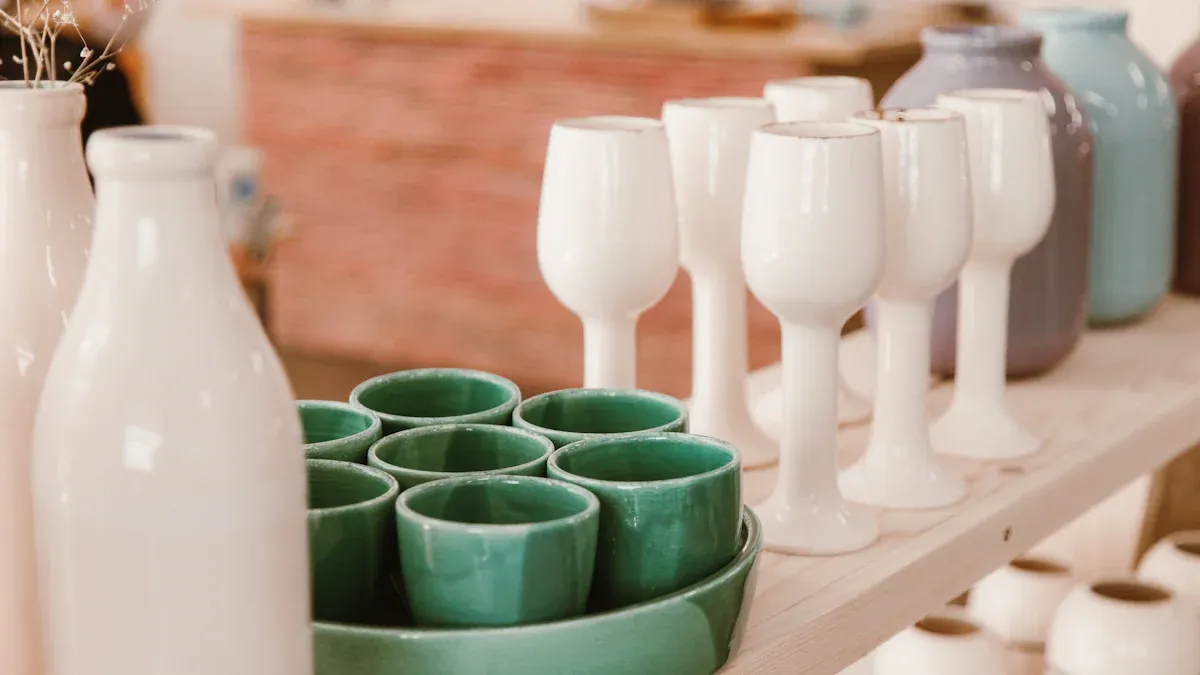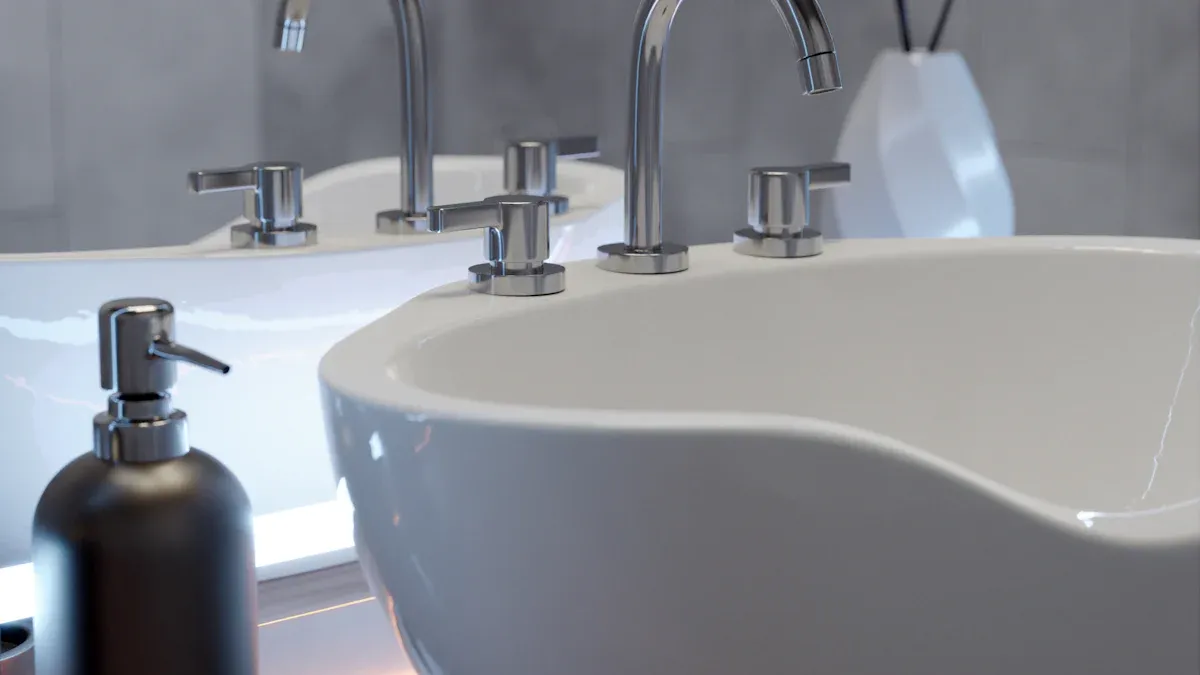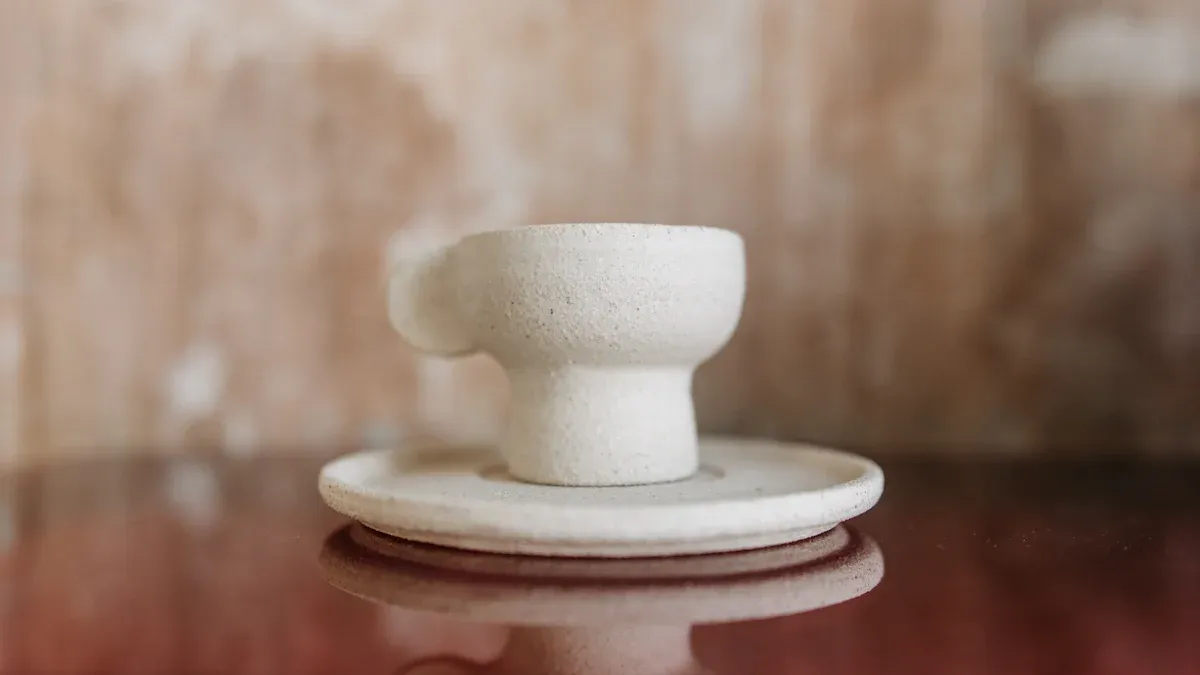
Ceramics can undergo PVD (Physical Vapor Deposition) coating, raising the question: can ceramics be PVD? When their properties are carefully considered, ceramics demonstrate high temperature resistance and vacuum compatibility, making them suitable for this advanced process. The ceramics segment in the PVD coatings market is projected to grow by 6.4% annually, driven by applications like titanium nitride coatings on cutting tools and precision parts.
Key Takeaways
- PVD coatings make ceramics stronger and last longer.
- Ceramics that handle heat and chemicals well work best with PVD.
- PVD coatings are great, but can be expensive and need careful prep.
The PVD Process and Its Compatibility with Ceramics

What is PVD and how does it work?
Physical Vapor Deposition (PVD) is a cutting-edge coating process that transforms solid materials into a vapor phase, which then condenses onto a substrate to form a thin film. This process occurs in a vacuum environment to ensure precision and purity. PVD involves several key steps:
- Cleaning: The substrate surface undergoes thorough cleaning to remove contaminants, ensuring optimal adhesion.
- Vaporization: The coating material is heated until it vaporizes.
- Transportation: Vaporized atoms travel through the vacuum chamber toward the substrate.
- Reaction: Chemical reactions may occur, depending on the desired coating properties.
- Deposition: A thin film forms on the substrate, creating a durable and functional coating.
Reliability and stability are critical performance metrics for PVD. Reliability is measured by the system’s productive uptime, while stability is assessed through the reproducibility of results across multiple runs. These factors ensure consistent, high-quality coatings, making PVD a preferred method for enhancing ceramic materials.
Key properties of ceramics relevant to PVD
Ceramics possess unique properties that make them suitable for PVD applications. Their thermal stability ensures that they can withstand the high temperatures involved in the process without degrading. Additionally, their chemical resistance allows them to endure harsh environments, making them ideal for applications requiring durability.
The following table highlights the technical performance metrics linking ceramic substrate properties to PVD efficiency:
| Metric | Description |
|---|---|
| Thermal Stability | Ensures stability and longevity of thin film coatings under high temperatures. |
| Electrical Insulation | Prevents short circuits, enhancing electronic device performance. |
| Mechanical Strength | Reduces mechanical failure risk, improving thin film coating durability. |
| Compatibility | Compatible with various deposition techniques, including PVD, allowing versatile fabrication. |
| Chemical Resistance | Enhances reliability and longevity of coatings in corrosive environments. |
| Adhesion | Influences thin film adhesion, preventing delamination through proper surface chemistry. |
| Interfacial Reaction | Certain substrate elements may react with thin films, affecting quality and interface properties. |
| Thermal Conductivity | Impacts heat dissipation during deposition, promoting uniform film deposition. |
| Electrical Properties | Affects dielectric constant and resistivity, influencing electronic device performance. |
These properties highlight why ceramics are increasingly used in PVD processes, particularly in industries requiring high-performance coatings.
Factors influencing PVD application on ceramics
Several factors determine the success of PVD coatings on ceramics. High temperatures and chemical reactions play a crucial role in enhancing the chemical bonding between the coating and the ceramic substrate. Vacuum compatibility is another critical factor. For instance, the VDM-2 Ceramic Diaphragm Vacuum Transducer demonstrates how ceramic components can maintain stability and reliability in harsh vacuum environments. Its corrosion resistance further enhances its suitability for PVD, allowing it to withstand aggressive chemicals and extreme conditions.
Environmental variables also impact the effectiveness of PVD coatings. Total pressure, water vapor pressure, and gas velocity significantly influence the performance of environmental barrier coatings (EBCs) on ceramics. Water vapor, in particular, affects oxidation resistance, while introducing pores into the coating can reduce stress by lowering the modulus. These considerations ensure that the PVD process is tailored to the specific requirements of ceramic substrates, maximizing their performance and longevity.
Benefits of PVD Coatings on Ceramics

Enhanced durability and wear resistance
PVD coatings significantly enhance the durability and wear resistance of ceramic materials. Experimental data demonstrates that the microhardness of PVD-coated ceramics can reach up to 990.4 HV, which is over three times higher than the base material’s microhardness of approximately 307.6 HV. This increase in hardness ensures that ceramic components can withstand mechanical stress and abrasive forces more effectively.
The fracture toughness of PVD-coated ceramics also improves, reaching approximately 7.56 MPa m1/2. This enhancement is attributed to the presence of cobalt and finely distributed ZrO2 particles within the coating, which hinder crack propagation. Additionally, the gradient effect in the coatings distributes mechanical stresses uniformly, reducing the likelihood of cracking or delamination.
Other features contributing to wear resistance include hard carbide phases and intermediate layers within the coating structure. These layers work synergistically to provide abrasion resistance while supporting the top layer, ensuring long-term durability. These advancements make PVD-coated ceramics ideal for applications requiring high-performance materials, such as cutting tools and industrial machinery.
Improved aesthetic and functional properties
PVD coatings elevate both the aesthetic and functional qualities of ceramics. In luxury markets, color evaluation plays a critical role in determining the visual appeal of ceramic products. The Lab* color space standardizes color measurements, ensuring consistency in production. The Euclidean distance (ΔE) within this color space quantifies color quality, with a ΔE ≥ 3 threshold indicating a noticeable improvement in aesthetic value.
Functional enhancements are equally impressive. PVD coatings provide ceramics with excellent wear resistance, a low coefficient of friction, and corrosion resistance. These properties ensure that ceramic components perform reliably in demanding environments. Anti-sticking and anti-fouling characteristics further enhance functionality, making PVD-coated ceramics suitable for applications in food processing and medical devices.
| Performance Metric | Description |
|---|---|
| Durability | Increases surface hardness (up to HV 4000) and reduces friction. |
| Wear Resistance | Enhances the ability to withstand wear, prolonging the life of the ceramic components. |
| Corrosion Resistance | Improves resistance to corrosive environments, ensuring longevity of the ceramics. |
| Aesthetic Appeal | Provides uniform metallic finishes and customizable colors for enhanced visual appeal. |
These improvements make PVD coatings a versatile solution for enhancing both the appearance and functionality of ceramic materials.
Applications in various industries
The versatility of PVD-coated ceramics has led to their adoption across multiple industries. In the aerospace sector, PVD coatings improve the thermal stability and wear resistance of ceramic components, ensuring reliable performance in extreme conditions. The automotive industry benefits from PVD-coated ceramics in engine components and braking systems, where durability and heat resistance are critical.
In the medical field, PVD coatings enhance the biocompatibility and corrosion resistance of ceramic implants and surgical tools. These coatings also provide anti-fouling properties, reducing the risk of contamination during medical procedures. The electronics industry utilizes PVD-coated ceramics for their electrical insulation and thermal conductivity, which improve the performance of semiconductors and other electronic devices.
Luxury goods manufacturers leverage PVD coatings to create visually appealing ceramic products with customizable finishes. Watches, jewelry, and decorative items benefit from the uniform metallic finishes and vibrant colors enabled by PVD technology. This combination of aesthetic and functional enhancements ensures that PVD-coated ceramics remain a preferred choice across diverse applications.
Challenges and Limitations of PVD on Ceramics
Technical challenges in applying PVD to ceramics
Applying PVD coatings to ceramics presents several technical challenges. The inherent brittleness of ceramics makes them prone to cracking during the coating process. High temperatures required for PVD can exacerbate this issue, especially if the ceramic substrate lacks sufficient thermal stability. Additionally, achieving strong adhesion between the coating and the ceramic surface can be difficult due to the material’s low ductility and unique surface chemistry.
Another challenge lies in controlling the uniformity of the coating. Variations in temperature or vapor flow within the vacuum chamber can lead to uneven deposition, affecting the coating’s performance. Advanced techniques, such as phase-field simulations, help optimize process parameters to address these issues. However, these methods require significant computational resources and expertise, making them less accessible for smaller-scale operations.
Limitations of PVD coatings on ceramic materials
Despite their advantages, PVD coatings have limitations when applied to ceramics. The process is highly sensitive to substrate preparation. Any surface contamination or irregularity can compromise the coating’s adhesion and durability. Furthermore, PVD coatings are typically thin, which limits their ability to provide substantial structural reinforcement.
The cost of PVD equipment and the complexity of the process also pose barriers. Small-scale manufacturers may find it challenging to justify the investment, especially for applications where alternative coating methods could suffice. Additionally, the coatings may not perform well under extreme mechanical loads, as their thin nature offers limited resistance to impact forces.
Considerations for successful PVD application
To ensure successful PVD application on ceramics, several best practices must be followed:
- Optimization of Process Parameters: Techniques like multi-objective optimization and phase-field simulations help determine ideal conditions for coating adhesion, hardness, and wear resistance.
- Surface Preparation: Thorough cleaning and polishing of the ceramic substrate enhance adhesion and reduce the risk of delamination.
- Advanced Monitoring: Real-time monitoring of temperature, pressure, and vapor flow ensures consistent coating quality.
- Experimental Validation: Combining simulations with experimental trials establishes reliable correlations between process parameters and coating properties.
These strategies address the challenges associated with PVD on ceramics, enabling manufacturers to achieve high-quality results. As technology advances, the feasibility of applying PVD coatings to ceramics continues to improve, expanding their potential applications across industries.
Ceramics can be successfully coated with PVD when the process aligns with their unique properties. This technique enhances durability, aesthetics, and environmental friendliness. However, challenges like cost and material compatibility persist. The table below consolidates the advantages and challenges of PVD coatings on ceramics:
| Advantages | Challenges |
|---|---|
| Improved Durability | Cost Factors |
| Better Corrosion Resistance | Material Compatibility Limitations |
| Enhanced Aesthetics | Complexity |
| Environmental Friendliness | N/A |
Advancements in technology continue to expand the possibilities of PVD applications, answering the question, “Can ceramics be PVD?” with a resounding yes.
FAQ
What types of ceramics are suitable for PVD coatings?
Ceramics with high thermal stability, chemical resistance, and smooth surfaces work best for PVD coatings. Examples include alumina, zirconia, and silicon nitride.
Tip: Always consult material specifications to confirm compatibility with PVD processes.
How thick are PVD coatings on ceramics?
PVD coatings typically range from 1 to 5 microns in thickness. This ensures durability without significantly altering the ceramic’s dimensions or weight.
Can PVD coatings on ceramics withstand extreme environments?
Yes, PVD coatings enhance ceramics’ resistance to heat, corrosion, and wear, making them suitable for aerospace, automotive, and industrial applications.
Note: Proper process optimization ensures coatings perform reliably under extreme conditions.
